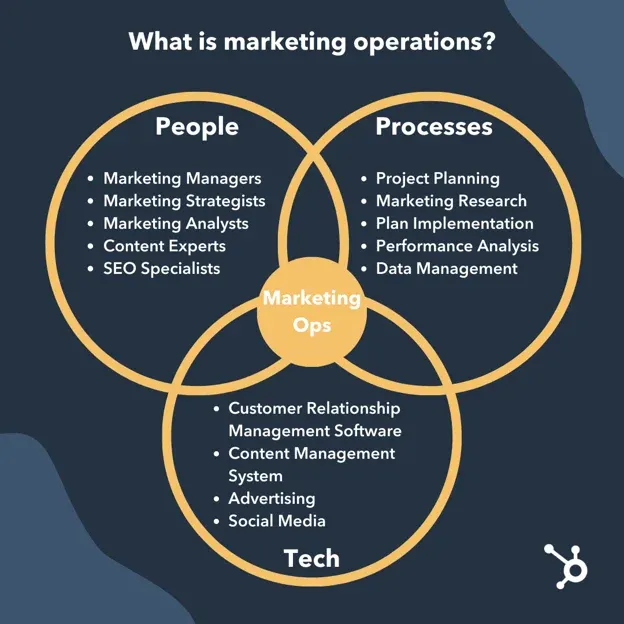Marketing operations (MarOps) has become an indispensable function for modern marketing teams seeking to maximize performance and align with overarching business objectives.
In this article, we’ll explore:
- Exactly what MarOps is
- The goals of MarOps
- The benefits of MarOps
- MarOps strategy
- The difference between MarOps and marketing
- The difference between MarOps and operations
- How to measure MarOps performance
- MarOps best practices
Understanding MarOps is key for any organization looking to streamline operations, boost marketing ROI, and adapt to the evolving digital landscape.
So, without further ado, let’s get started.
What is MarOps or “marketing operations?”
Marketing operations, also known as MarOps, MOps, or MarkOps – not to be confused with RevOps – is an umbrella term that describes a company’s marketing program, including:
- The people: Marketing managers, strategists, analysts, content experts, etc.
- The processes: Market research, campaign planning, performance analysis, strategic planning activities, etc.
- The technology: Content management systems, CRM software, social media, etc.

Together, these MarOps elements work cohesively to support a business’s overall marketing approach and drive success.
MarOps builds the infrastructure required for seamless marketing execution at scale. It seeks to connect strategy to execution, ensuring alignment across teams, systems, and objectives. In essence, MarOps is the engine that propels marketing performance.
What are the goals and responsibilities of MarOps?
The overarching goal of MarOps is to build an efficient backbone to support marketing team execution at scale.
It aims to bridge gaps between high-level marketing strategies and ground-level activities. MarOps connects insights to action, oversees operations, and enables data-driven marketing.
Key responsibilities include:
- Managing marketing technologies and systems
- Developing workflows and processes
- Ensuring data accuracy and availability
- Overseeing campaign deployment and lead management
- Performing analysis and reporting
And more!
What are the benefits of MarOps?
The adoption of MarOps brings a myriad of advantages for businesses in bolstering marketing efforts and driving success.
Improved efficiency
By developing automated systems and streamlined processes, MarOps saves time and manual work for marketers. This allows them to focus their energies on strategy, creativity, and execution rather than tactical operations.
Enhanced data & reporting
MarOps oversees data management and reporting. This provides accurate insights that inform campaign optimization and future strategies. As such, dashboards become more informative.
Better collaboration
MarOps breaks down silos between teams by clarifying roles, processes, and systems. This facilitates seamless cross-functional cooperation.

Higher returns
With optimized operations and a data-driven approach, MarOps enables greater campaign reach and conversion rates. Results improve across metrics.
Future-proofing
MarOps evaluates new marketing technologies and ensures systems stay updated. This positions teams to capitalize on innovations.
Scalability
With robust processes and frameworks, marketing programs can efficiently scale up or down as needed. MarOps enables growth.
Risk reduction
Governance and compliance monitoring from MarOps minimizes risks like data breaches. Budgets and resources are also optimized.
The benefits of MarOps are vast. Advantages like adaptability to digital transformation, efficient monitoring, enhanced organization of assets, and clear role delineation, all contribute to the overall success of your marketing initiatives.
What is a MarOps strategy?
A MarOps strategy provides a detailed roadmap for how marketing operations capabilities will be developed and managed to align with business objectives. It starts with setting SMART (specific, measurable, achievable, realistic, timebound) goals based on overall corporate strategy.
Current marketing operations processes are audited to identify gaps and improvement areas. An inventory of existing technologies is taken before building a timeline of new platforms or upgrades required to enable success.
The strategy itself outlines roles, governance models, and frameworks to guide MarOps expansion, and new capabilities are rolled out in phases using continuous improvement approaches.
The MarOps strategy facilitates collaboration between teams and provides training on new procedures – facilitating ongoing cross-functional collaboration. It institutes reporting ecosystems to inform continual optimization.
There is no one-size-fits-all MarOps strategy, but some best practices include:
- Conducting an audit of current marketing operations maturity and pain points.
- Defining MarOps vision, objectives, and success metrics based on overall business strategy.
- Taking inventory of existing marketing technology and processes to identify gaps or inefficiencies.
- Building a roadmap for MarOps capabilities and systems needed to enable marketing success.
- Securing executive buy-in and budget for MarOps initiatives.
- Developing governance models and frameworks to guide MarOps implementations.
- Hiring personnel with specialized MarOps experience to lead projects.
- Beginning with foundational elements like data, analytics, and technology infrastructure.
- Rolling out new MarOps capabilities using phased approaches and continuous improvement.
- Fostering collaboration between MarOps and other departments like IT, sales, and creative.
- Providing training and education to end-users on new MarOps processes.
- Auditing and optimizing regularly based on results, feedback, and market trends.
A MarOps strategy details both the strategic vision and tactical steps necessary to cultivate best-in-class marketing operations.
Though it requires both strategic vision and tactical follow-through, the overarching goal is developing capabilities over time that provide the greatest impact and value. It requires both strategic vision and tactical follow-through.
What’s an example of MarOps?
Let’s take the example of implementing a customer data management system within a marketing team.
In this scenario, the MarOps team is tasked with overseeing the organization, structuring, and accessibility of customer data utilized by the marketing department. The goal is to ensure the completeness and unity of the data, enabling the marketing team to effectively leverage it for targeted campaigns and strategic decision-making.
In practice, the MarOps team establishes and enforces naming standards for customer data, facilitating efficient tracking and utilization. They also implement data analytics, leveraging insights into customer behavior to refine marketing strategies.
This involves assessing engagement across various channels, enabling a more personalized and effective approach to customer engagement.

The MarOps team might conduct competitive intelligence research to stay up-to-date on competitors' marketing strategies and tactics. By doing so, they contribute valuable insights to the overall marketing strategy, enabling the business to position itself advantageously in the market.
Of course, this is an oversimplification, but it quickly illustrates how MarOps, through effective data management and strategic research, enhances the marketing team's capabilities and contributes to the overall success of marketing initiatives.
Quickfire examples of MarOps activities
- Integrating marketing technologies into a centralized CRM system and ensuring seamless data flows between systems.
- Developing standardized campaign performance reports and dashboards across email, social, paid search, etc.
- Building workflows and templates in marketing automation platforms to scale lead nurturing programs.
- Maintaining addressable customer databases and audience segmentation for targeting.
- Implementing A/B testing protocols and tools to experiment and optimize campaigns.
- Analyzing multi-touch attribution to understand customer journeys across channels.

- Establishing SLAs (service level agreements) for working with creative agencies.
- Implementing digital asset management solutions and enforcement of branding guidelines.
- Developing documentation, operating procedures and help resources on marketing systems.
- Monitoring marketing tech stack for redundancies and gaps; making upgrade recommendations.
- Auditing GDPR compliance across marketing programs and platforms.
What’s the difference between MarOps and marketing?
While complementary, marketing and MarOps have distinct focuses. Let’s have a look at a few now.
Marketing develops strategies and handles creative
Marketing deals with outward-facing strategy, messaging, and creative campaign execution. It interacts directly with customers through various channels and content.
The emphasis is on driving growth and acquiring, engaging, and retaining users.
MarOps handles operationalization and optimization
MarOps involves inward-facing coordination and optimization of marketing operations. It focuses on systems, data, and processes that enable smooth marketing execution. MarOps oversees behind-the-scenes workflow and cross-functional alignment.
In essence, marketing drives top-line results while MarOps drives efficiency. Together, they form a symbiotic relationship where MarOps provides the optimized backbone for marketing to thrive.
Some key differences:
- Marketing drives business results and growth; MarOps drives marketing performance.
- Marketing focuses on customers and external brand messaging; MarOps focuses on internal workflow.
- Marketing initiatives are guided by strategies; MarOps initiatives are guided by processes and frameworks.
- Marketing roles include managers, copywriters, and designers; MarOps roles are centered on operations, analytics, and technology.
- Marketing measures business metrics like revenue and market share; MarOps measures operational metrics like cost-per-click and system adoption.
- Marketing is concerned with "what" key initiatives; MarOps is concerned with "how" to implement them smoothly.
What’s the difference between MarOps and operations?
While the term "operations" refers to the broad coordination and management of organizational resources and functions, "marketing operations" (MarOps) specifically relates to the processes and strategies within the marketing department.
Operations
General operations involve company-wide oversight of departments like human resources, finance, supply chain, and more.
It takes a holistic view of managing personnel, assets, and overall workflow.
MarOps
In contrast, MarOps focuses narrowly on marketing functions. It entails orchestrating marketing technology, systems, data, and staff to optimize marketing performance.
MarOps alignments are tailored to achieving marketing key performance indicators (KPIs) and campaign success metrics.
Overall, general operations have a wider organizational scope, while MarOps concentrates specifically on the complexities and nuances of marketing operations. However, they both work synergistically to drive overall performance.
How do you measure MarOps performance?
Measuring MarOps is no simple checklist. It requires a multivariate approach to gain a true 360-degree view.
Key MarOps indicators to track
- Marketing technology optimization: How adeptly does MarOps implement new platforms and maximize existing stacks? Tracking adoption rates, integration efficacy, and data flows provides insight.
- Process improvement: How well does MarOps develop and document processes? Assessing campaign velocity, workflow efficiency, compliance, and standardization reveals progress.
- Resource efficiency: How strategically does MarOps allocate budget and personnel? Marketing headcount ratios, budget utilization, and tool/agency usage rates tell the tale.

- Productivity: How reliably does MarOps accelerate workflows? The volume and speed of campaign builds, asset production, and task completion speak volumes.
- Data management: How effectively does MarOps wrangle data? Audit frequency, attribution insights, and customer record health highlight data dexterity.
- Reporting: How competently does MarOps distill data into insights? The number of dashboards, analytical cadence, and stakeholder alignment reflect acumen.
MarOps has many factors to monitor and take into consideration. But tracking the right metrics ensures your strategies are smooth, your decision-making ability is enhanced, your campaigns are optimized, and your company experiences sustainable growth.
MarOps best practices
The most adept MarOps pros adhere to key principles that ultimately enable marketing success:
Secure executive buy-in
Obtaining executive sponsorship is crucial for unlocking the resources and influence needed to mature MarOps.
With c-suite champions advocating for its strategic importance, MarOps gains legitimacy and priority. Executives can allocate budget, talent, and technology to fuel success, and their leadership galvanizes adoption across the organization.
Partner with executives to craft a compelling vision and business case, and ensure MarOps initiatives ladder up to company objectives.
Phase rollouts
“Big Bang” MarOps implementations often fail. They try to revolutionize marketing overnight leading to chaos, confusion, and change fatigue.
Take an incremental, crawl-walk-run approach instead: Assess which foundational elements are most needed by marketing teams and start there. Is it getting data flows under control? Is it standing up an insights reporting dashboard?
Determine priority needs, deliver tangible value in digestible phases, and build positive momentum. Phasing maximizes adoption and ensures MarOps sticks the landing, so let change be gradual and ongoing based on feedback.
Recruit spotlight talent
Recruit data, tech, and analytical whizzes with operational savvy to navigate complexity.
The skills engine powering MarOps must be finely tuned.
Seek data scientists who find insights in datasets; pursue engineers who streamline intricate marketing technology stacks; recruit operational gurus that synthesize processes across people and systems.
Understanding marketing’s technical complexities and identifying optimization opportunities requires specialized expertise. Build a culture of continuous learning and development and cross-train marketers on MarOps capabilities.
Talent shortages can cause major turbulence, so invest in the right seats and skills where possible.
Foster cross-functional relationships
Siloed functions stifle the potential of every business and its departments, and MarOps is no different.
Here’s how you can knock down internal barriers and work to prevent siloed information:
- Facilitate collaboration across teams
- Strengthen connections through knowledge-sharing forums
- Embed MarOps members within marketing for tighter alignment
- Develop joint success metrics that incentivize cooperation
- Ensure sales, creative, and IT all have visibility into MarOps roadmaps
For people to get on board with cross-functional working, they need to know the benefits, so underscore how optimizing marketing operations creates enterprise-wide efficiencies and long-term growth.

Develop governance
Consistency and alignment accelerate MarOps' impact. Document guidelines, policies, frameworks, and procedures that codify best practices. This’ll help to eliminate knowledge gaps and ambiguity.
Clarity is essential, so create oversight models that provide clear direction without sacrificing agility, standardize platforms, processes, and protocols to drive efficiency, promote governance structures flexible enough for regular re-evaluation in an evolving landscape, and enable skills transfer and onboarding through established guardrails.
Well-defined but not overly bureaucratic governance gives MarOps thrust and minimizes turbulence.
Document everything
Documentation is the key to preserving marketing’s technical complexities and nuances as teams scale. It reduces redundant efforts, allows for self-service learning, and enables marketers to move further by standing on the shoulders of past successes.
MarOps needs to serve as the steward of institutional knowledge, capturing expertise through meticulous documentation at every turn. Rather than scrambling to recreate past triumphs, meticulous documentation allows teams to build upon what worked before and grow.
This may involve building expansive internal knowledge bases where both strategic and tactical expertise are codified. Playbooks can outline ideal workflows and requirements so best practices are propagated, and post-mortems should translate lessons from assessments into concrete guidelines for improvement.
Standard terminologies and methodologies should also be established to enable cohesion across tools, channels, and teams.
Data first, then decisions
Many marketers are eager to leap right into sophisticated analytics before getting grounded in quality data. But compromised data leads teams astray, no matter how advanced the analysis. MarOps teams need to cultivate strong data foundations before layered decision-making can thrive.
This starts with investments in robust customer data infrastructure, collections tools, and data warehousing. Establishing rigorous QA processes ensures bad data is detected early, and ongoing monitoring should assess health metrics like accuracy, completeness, and consistency.
Responsibilities for maintenance and governance should be clear.
Maintain agility
Agility is critical to staying competitive. While governance brings needed structure, excessive bureaucracy can limit quick reactions to shifting customer behaviors and market dynamics. Rather than enforcing rigid protocols, MarOps should focus on cultivating nimble teams empowered to respond to an ever-evolving environment.
This involves establishing adaptable systems and modular technology architecture that provide flexibility. Continual improvement should be baked into processes to keep pace with innovations. Measured risk-taking and rapid experimentation should be encouraged to spur creative solutions.
Although structure is crucial, don’t stifle teams with prescriptive rules and static systems that’re unable to keep up with accelerating industry change. When your foundations are agile, you can navigate and position marketing activities to capitalize on emerging opportunities.
A flexible team provides the dexterity to stay ahead of the game.
Institutionalize insights
Data holds little value in isolation. The solution? Constructing tight feedback loops that convert data into actionable insights. Rather than siloed analysis, insights should permeate every aspect of marketing.
This starts by making insights accessible and transparent through live dashboards. Alerts can be established to trigger when metrics pass key thresholds, and reporting cadences ensure insights reach decision-makers while still relevant.
A culture of inquiry and optimization should take root, with teams asking probing questions about their data and circulating findings company-wide.
Evangelize internally
Securing broad internal buy-in is crucial for marketing operations to gain altitude. Too often MarOps can seem ambiguous or disconnected from the day-to-day of marketers.
The key is consistent communication on how optimized operations will make employees' lives easier: Milestones and quick wins should be celebrated to exhibit tangible impact. While skeptics may need customized training that underscores how MarOps provides fuel for marketing campaigns, concerns can be preempted by inviting input into roadmaps and plans.
You can build a coalition of allies across departments with education, transparency, and inclusiveness.
What is MarOps: Final thoughts
MarOps is indispensable for modern marketing teams.
To achieve digital transformation and data-driven growth, implementing marketing operations best practices is essential. With optimized operations, collaboration, and vision, MarOps accelerates marketing performance.
Organizations that invest in maturing their MarOps capabilities will gain a significant competitive advantage and unlock strategic marketing excellence.
Now's your chance to influence the most important conversations in revenue marketing
Our comprehensive 2024 Customer Acquisition and Marketing Attribution Survey will reveal the inner workings of today's state-of-the-art revenue engines. And you can help uncover the key insights.
🌱 How do leading marketers drive growth?
🗣️ What channels attract and convert customers?
💸 Where should budgets be allocated?
📊 What metrics matter most?
The insights gained will be invaluable for staying ahead of rapid changes in 2024.
This is your exclusive opportunity to shed light on:
- Current marketing attribution models and challenges
- The evolving customer journey to purchase
- How teams track and optimize funnel performance
- Emerging strategies to connect with modern buyers
- Key focus areas for growth in 2024
… And a whole lot more.
Take the survey, and at the end, receive a comprehensive Customer Journey framework slide deck to help you and your team acquire more customers with less stress! 👇





